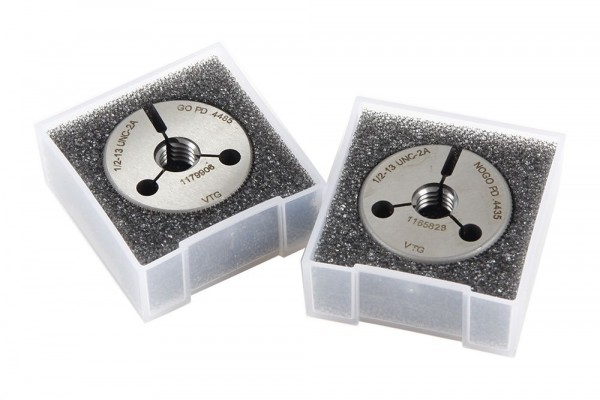Setting Adjustable Thread Ring Gages
The pitch diameter of a thread ring gage is best established by adjusting the ring to a truncated thread setting plug. The setting plug should previously have been inspected and known to be in good condition, of the correct pitch diameter size and within thread element specifications.
The following methods are used to adjust the ring and to insure the proper pitch diameter setting.
- Thoroughly clean both the ring and plug gages by immersing in good cleaning solution and jet-blow dry, or preferably clean ultrasonically if possible. Then visually inspect to make sure all foreign material in the threads has been removed and no nicks or burrs are present.
- Lubricate the plug with a thin film of light viscosity oil before assembling with the ring gage.
- Turn the locking screw of the ring counter-clockwise until it is loosened, but do not remove it from the ring.
- Turn the adjusting screw clockwise to open the ring to a larger pitch diameter than the setting plug.
- Turn the ring onto the setting plug until it is completely engaged with at least one thread of the ring extending beyond the last thread on the back end of the full form section of the setting plug. (This promotes uniform wear over the entire thread length of the plug.
- Turn the adjusting screw counter-clockwise until there is a slight drag between the ring and setting plug.
- Turn the locking screw clockwise until tight, this locks the adjusting screw so that the pitch diameter of the ring remains fixed. There should now be a noticeable drag between the ring and setting plug.
- Operations No. 6 and 7 may have to be repeated more than once to get the proper adjustment.
- Unscrew the setting plug from the ring.
- Screw the setting plug into the ring approximately one and a half turns and try to move it from side to side to test the ring for a taper or bellmouth condition. NOTE: In checking for shake, use light pressure on the setting plug to avoid damaging the end threads.
- Remembering the feel at the one and a half thread engagement, screw the ring over the truncated and full form sections of the setting plug. The drag or feel should remain approximately the same, perhaps a little more drag at the full form engagement due to more flank contact.
- Remove the setting plug from the ring and repeat operation No. 11 on other side of the ring.
- The assembly of the ring and setting plug should feel the same from either side of the ring. This insures a straight pitch diameter.
When the ring gage is set to the setting plug with uniform feel over the entire length of the plug, including no end thread shake, it is correctly mated with the plug. However, it is well to remember that because of tolerances in the manufacture of both the ring and the setting plug, and that unless they are made at the same time or ordered to be mated with each other, allowances must be made in the assembly feel or fit to compensate for slight differences. For instance, a slight difference in angle and/or Lead cause more of a tightening or drag at full engagement than over partial engagements. This is not a serious condition as both the ring and setting plug may well be within specifications.
If the ring gage is set to the truncated portion of the setting plug first instead of the reverse procedure described above, and it fails to pass over the first full thread of the full form section of the plug, there is major diameter interference in the ring and it should be repaired or otherwise the ring will not engage properly.
